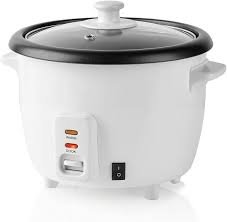Cooking rice may seem like a basic culinary task, but achieving that perfect fluffiness and texture can sometimes be elusive, especially for those just starting out. Thankfully, with the advent of rice cookers, this process has been greatly simplified. However, for a beginner, knowing exactly when the rice cooker has completed its job might not be so obvious. At TheKitchenApplianceDad.com, we understand the nuances of kitchen appliances and are here to guide you through the process of using a rice cooker efficiently.
Before diving into the telltale signs of when your rice is ready, it’s important to understand how a rice cooker works. Rice cookers typically operate using a simple principle: they heat the rice and water mixture until all the water is either absorbed by the rice or evaporated as steam. Once the temperature in the pot begins to rise above the boiling point of water (100°C or 212°F), the rice cooker senses the temperature change and either switches off or changes to a ‘warm’ setting.

To ensure your rice cooks properly, it’s vital to start with the correct water-to-rice ratio. Typically, this is 2 cups of water to 1 cup of rice for white rice, but it can vary depending on the type of rice and your personal preference for texture. Always refer to the manual of your specific rice cooker model or the rice packaging for the best results.
The most obvious sign is that the rice cooker will switch from ‘Cook’ to ‘Warm.’ This is the rice cooker’s way of telling you that it no longer detects any water at the base of the pot and that the cooking process is complete. The ‘Warm’ setting will keep your rice at an optimal temperature for serving without overcooking it.
During the cooking process, steam will escape through a vent or valve on the lid of the rice cooker. When the rice is done, the production of steam will slow down noticeably or stop altogether. While you shouldn’t open the lid frequently to check—this can disrupt the cooking process—you can observe this from the outside.
If your rice cooker has a digital timer, it will alert you when the rice is finished cooking. This feature is especially useful for rice cookers with specific settings for different types of rice or for rice dishes that require a precise cooking time.
While not recommended to do frequently as it can affect the cooking process, if your rice cooker doesn’t have a timer or automatic switch-off, you may need to check the rice towards the end of the expected cooking time. Carefully open the lid and use a rice paddle to move some rice aside to see if there is any water left at the bottom.
Another subtle indicator is the aroma of cooked rice filling your kitchen. When you start to smell that distinct, comforting scent, it’s a good sign that your rice is nearly or completely done.
Rinsing your rice before cooking can remove excess starch, which causes rice to be sticky. Rinse until the water runs clear, then drain before cooking.
After your rice cooker switches to ‘Warm,’ let the rice sit with the lid closed for about 10 minutes. This allows the rice to settle and the remaining moisture to distribute evenly.
Once the rice has rested, use a fork or rice paddle to gently fluff the rice. This helps to separate the grains and release excess steam, preventing the rice from becoming mushy or overly sticky.
Resist the urge to open the lid to peek during cooking. Doing so can release steam and heat, which can affect the cooking time and the texture of the rice.
Each rice cooker can vary in terms of cooking times and settings. Familiarize yourself with your specific model to get the best results.
Most modern rice cookers come with an automatic shut-off and a ‘keep warm’ function. These features are designed to take the guesswork out of rice cooking. As mentioned earlier, the switch to ‘warm’ mode is a clear indicator that your rice is done. However, it’s important to note that rice can dry out if left on ‘warm’ for too long, so it’s advisable to serve the rice within an hour or two of cooking.
Different types of rice require different water ratios and cooking times. Here are some general guidelines for popular varieties:
Always check the specific instructions for the type of rice you’re using and adjust according to your rice cooker’s guidelines.
To ensure your rice cooker works effectively for each use, it’s crucial to clean it after every batch. Allow the cooker to cool down, then wash the inner pot with warm soapy water, rinse, and dry. Wipe down the exterior and the heating element with a damp cloth. Avoid submerging the entire cooker in water or using abrasive cleaners on any part of the appliance.
Rice cookers are designed to make the process of cooking rice as foolproof as possible, but knowing when your rice is perfectly cooked can still require a bit of attention and experience. By following this beginner’s guide, you’ll be on your way to achieving perfectly cooked rice every time. Remember that at TheKitchenApplianceDad.com, we’re always here to help you navigate the ins and outs of your kitchen appliances. Enjoy your perfectly cooked rice, and here’s to many more successful meals!

